The word “tiki” specifically refers to a stone or wooden carving, usually with a sinister face representing a god of some sort, found throughout the Polynesian islands — but sometime around the ’40s and ’50s it came to mean a lot more. It became a culture represented by colorful umbrella-adorned cocktails and ceramic mugs, Hawaiian-print wardrobes, kitschy island home decor, and surf and exotica music. Capturing the care-free escapism one feels while on vacation, particularly an island vacation, tiki culture’s vibrant aesthetics are undeniably retro; and yet, they remain timeless, maintaining an avid following of diehard drinkers and collectors and seducing new enthusiasts with cheerful and friendly vibes.
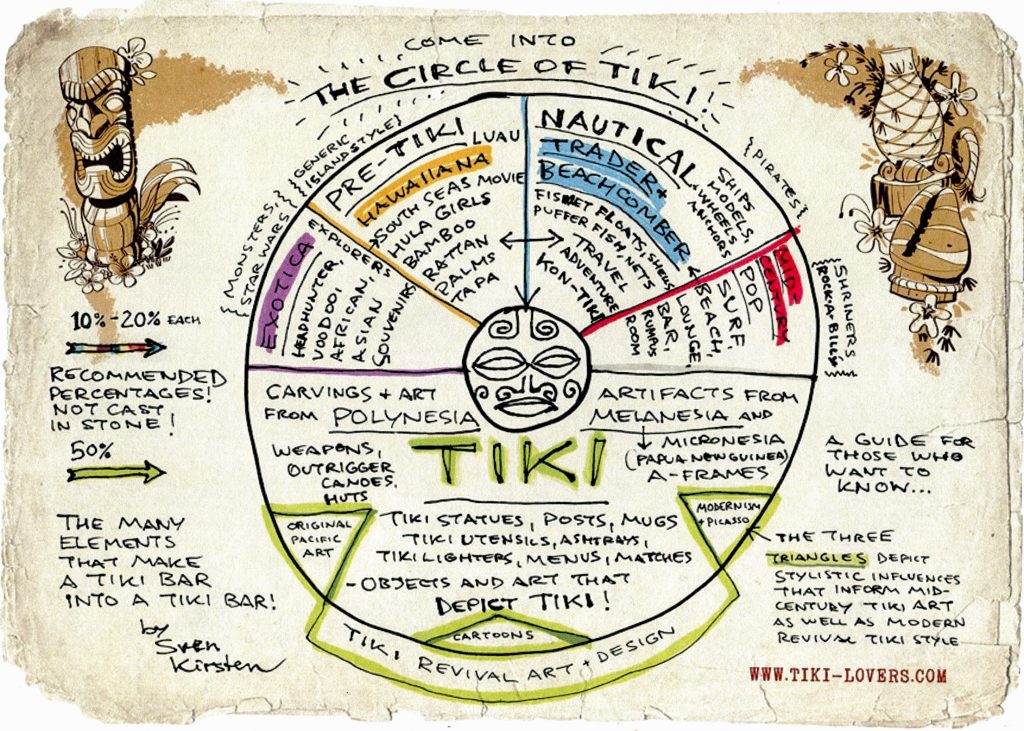
“The Circle of Tiki.” (Courtesy Sven Kirsten)
“It encompasses so many things,” says L.A. author Sven Kirsten, the recognized authority on all things tiki, with four books about the topic for Taschen to prove it. “It’s kind of a roleplay thing — it’s cocktails, it’s music, it’s fashion, and to me as a cinematographer who came to it from the visual side, it’s very much about design and architecture, which I put forth in my books.”
Though there were times when tiki’s popularity waned a bit, it was always a cool niche interest surviving inside a handful of restaurants across the country (some of the most memorable right there in L.A.) and home tiki bars. The latter, DIY hatch and bamboo-swathed structures with touches both nautical and campy, were usually found on neighborhood back patios or, if inside, as kitchen-adjacent drinking stations. In many ways they were the first “man caves,” though their fanciful elements and tasty treats appealed to women as well.
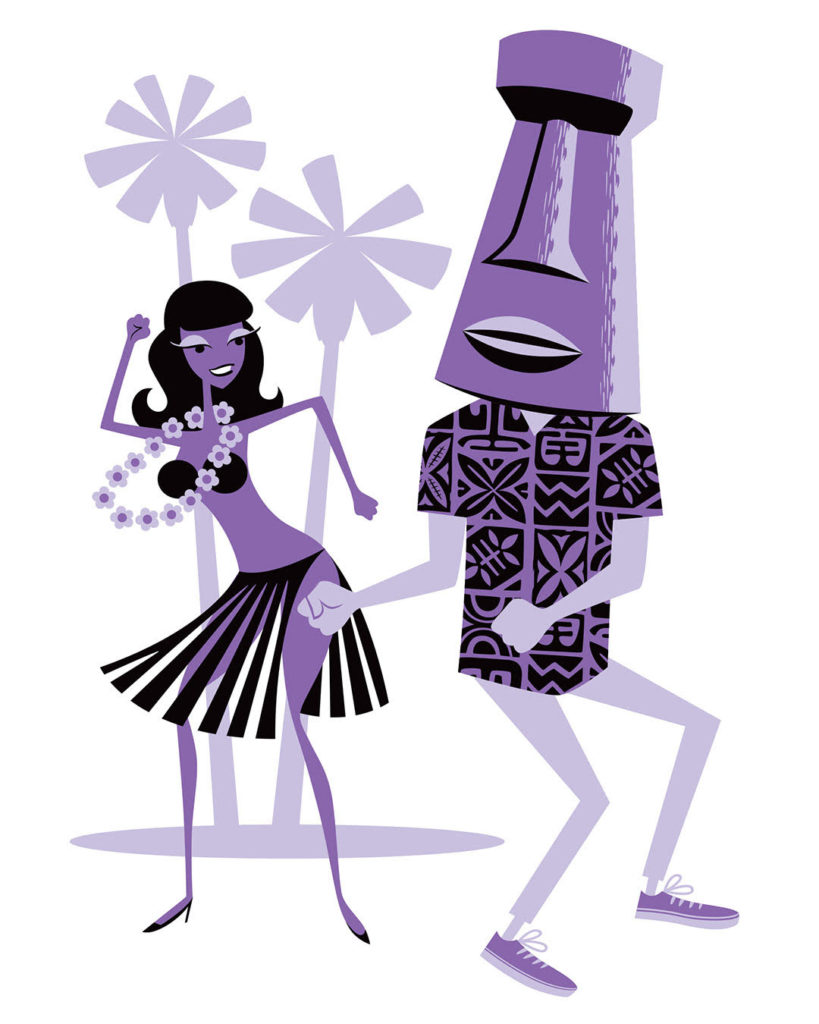
“Mr. Tiki Head Hula!” (Courtesy Shag)
“After the war, the islands became the dream destination for Americans, and with jet travel and Hawaii becoming a state it came into reach of thousands more people,” Kirtsen explains. “So they reimported it into their own backyards. And that was also the appeal of the tiki bars, which said ‘you don’t have to go to Hawaii, you can come here.’ ”
In California, tiki destinations pretty much established the culture in general in terms of nightlife and hospitality. Don the Beachcomber (a.k.a. Ernest Raymond Beaumont Gantt) was pivotal and his Huntington Beach namesake was our most honored landmark until it was sold to new owners and eventually closed. Trader Vic’s followed, attracting Hollywood types with its fantasy, frolic and frothy libations.
Though tiki faded a bit from the ’70s through the ’90s, some original bars and eateries survived — Bahooka was big favorite before closing six years ago while Damon’s Steakhouse offered a place to soak up island vibes (and still does). Many believe the authenticity and drink quality diminished during this period, as public interest did, but the scene always had its die-hards. As far as the general public’s recognition of tiki, it was probably Chinese restaurants that really helped with that, as their drinks (and take-home souvenir mugs) remained a staple on menus consistently, even when they weren’t so trendy.
“Chinese restaurants and tiki bars all shared one thing — America’s passion for the exotic, at that time in the postwar era it really didn’t matter the origin of the exotic as long it was exotic,” explains Bobby Green, who just re-opened the Formosa in West Hollywood and made sure to include some classic tiki-style cocktails. “Tiki restaurants serve Chinese food, Chinese restaurants served what we now know as tiki drinks, and it was all a very symbiotic relationship.”
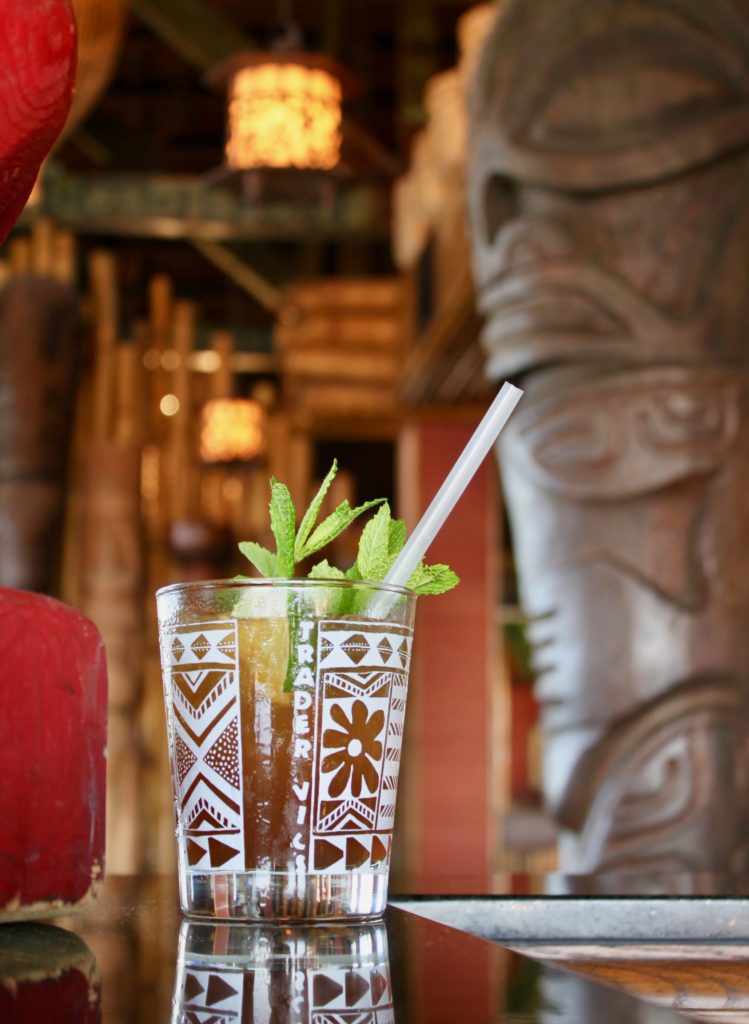
(Sven Kirsten)
It was the mixology trend, not restaurants, that gave the tiki scene its biggest shot (of rum) in the arm. Around the early 2000s, bars and nightlife saw a return to its fresh ingredients and whimsical presentation, and many bartenders sought inspiration from classic tropical recipes, as seen in Jeff “Beachbum” Berry’s bible of tiki cocktails known as The Grog Log. Art shows and books (Kirsten’s specifically) celebrating every aspect of the culture — home design, mugs, branded swizzle sticks for stirring, totems, floral fashion, etc. — followed and suddenly, it seemed vintage mongers had a new obsession.
Los Angeles is largely recognized as a tiki capital, thanks to family-owned Tiki Ti (opened by Ray Buhen, who worked at Beachcomber, Seven Seas in Hollywood and The Luau in Beverly Hills; now run by his son Mike and his sons) in Silver Lake and the San Fernando Valley mainstay The Tonga Hut (which immortalizes patrons who can drink the entire Grog Log on its wall). San Francisco is a tiki destination these days thanks to rum master Martin Cate’s bars, but Palm Springs (the Shag store and Tonga Hut P.S.) and San Diego are right behind or beside us, depending on who you talk to. The latter has in fact become one of the most high profile places to immerse oneself in tiki culture, thanks to L.A.-bred, S.F.-based events guru Otto von Stroheim and his wife “Baby” Doe von Stroheim (of burlesque and go-go dance group The Devil-Ettes), who have been throwing the biggest tiki event in the country, Tiki Oasis, for 19 years now every summer.
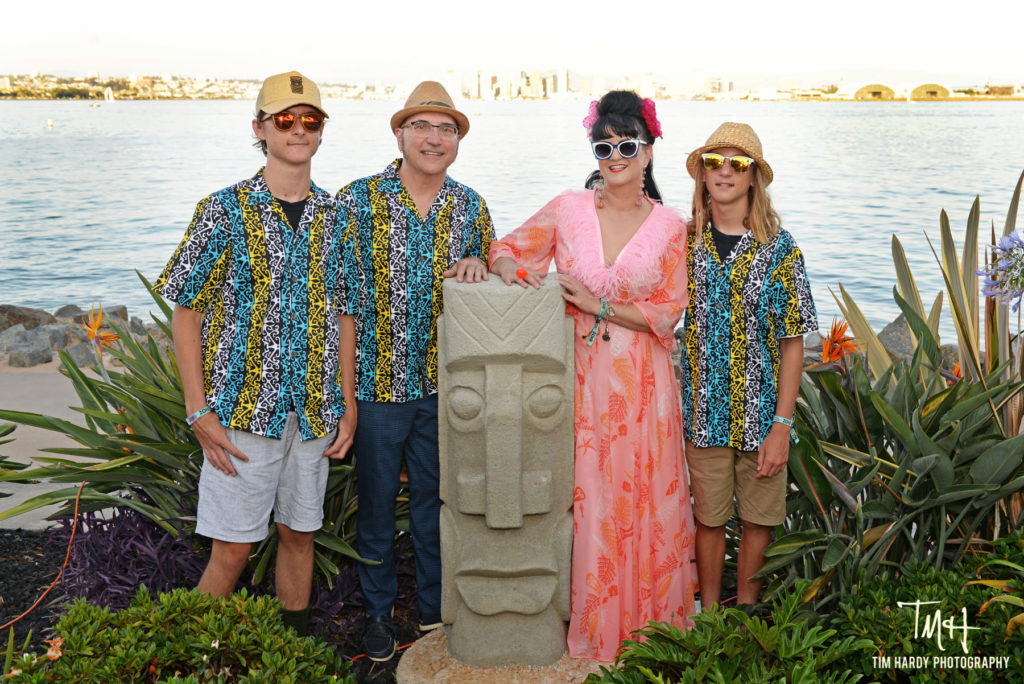
Otto and Baby Doe von Stroheim and their two sons. (Tim Hardy Photography)
Oasis began in Palm Springs, but has called San Diego’s Crowne Plaza hotel (a tiki-themed hotel) home for several years now, attracting thousands every year for a wild weekend of vibrant vintage and island dress-up, live music, educational symposiums, art, shopping, burlesque, contests and non-stop booze. It takes over the entire hotel, and in addition to two stages, a car show and the five days of entertainment and events, the people who stay there throw elaborate room parties most nights into the wee hours.
Von Stroheim, who comes from the punk scene originally, got his start throwing tiki-themed backyard bashes back in the late ’80s when he lived in Venice Beach. After starting a zine that covered tiki life, he began promoting the Oasis with Doe. Two kids and 20-plus events under their grass skirts later, Tiki O remains one of alternative culture’s biggest and best weekenders out there, a happening boasting family-friendly elements that also manages to capture a hedonist spirit for adults.
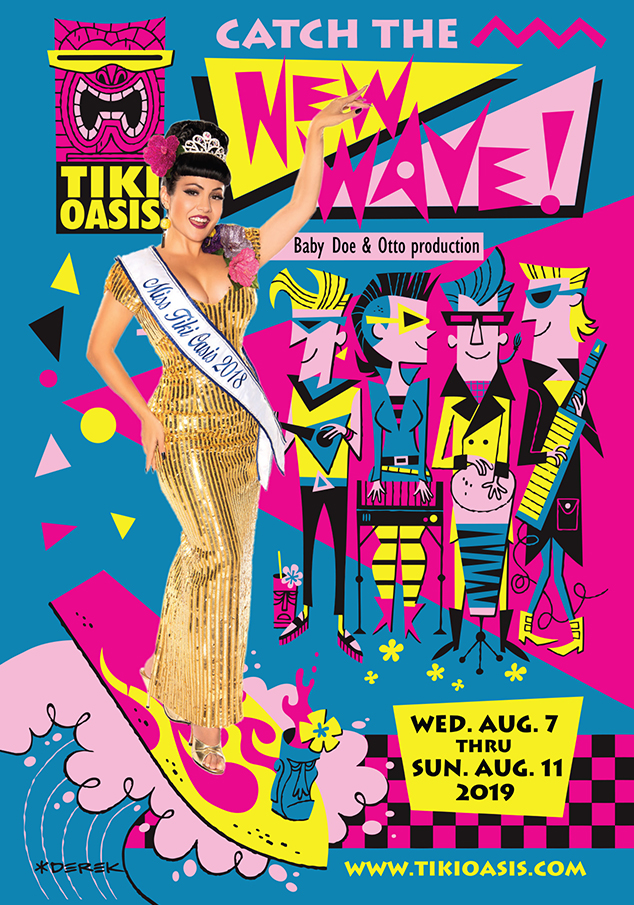
Last year’s Miss Tiki Oasis Ruby Champagne & promo art for this year’s Tiki Oasis. (Courtesy the von Stoheims)
It’s a very immersive event. You can go and be a looky-loo, but at some point you’ll want to participate in the fun too, donning florals and brights like the regulars (lots of vendors are on-hand to make this easy), sampling the liquor available (rum sponsors abound) and getting into the music, which is a big part of what this event is all about, often driving the “theme” the promoters choose each year.
Past events themes have included 2014’s “Beat Tiki” (beatnik), 2015’s “Tiki in Outer Space,” and 2016’s “Monster Island,” all of which invited attendees to bust out wild Comic-Con–esque level costumes. Though the time frame for themes has always been within the pretty strict window of ’50s and ’60s culture (pin-up, mid-century modern and Old Hollywood all fold in nicely) this year, the von Stroheims are doing something very different which seems to have generated renewed excitement for the event, even as some purists seem a little skeptical.
Titled “Catch the New Wave,” Tiki Oasis goes ‘80s this year, celebrating the era of crazy hair and gaudy makeup with a decidedly alternative punk rock/new romantic spirit that will reference not only synthy British bands, but also a lot of surf and rockabilly as well, both of which saw resurgence in the decade. While the ’80s might not immediately scream “tiki,” moving a little forward era-wise makes sense when you think about the outsider elements of the culture and the kind of people who are most into it. Patrons will be dressing up for the ’80s theme on Saturday night, which also corresponds with the T.O.’s costume contest (lots of Devo domes, geometric sunglasses and flashy Madonna/Cyndi Lauper jewelry and hair are expected).
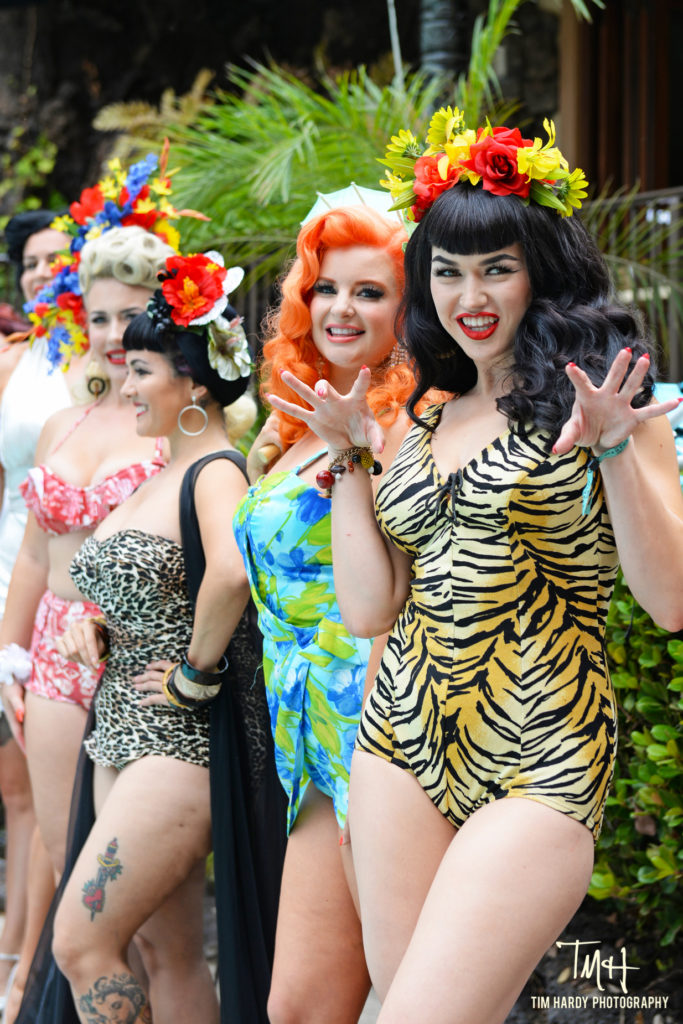
Tiki Oasis beauties. (Tim Hardy Photography)
Fashion and theme dress-up are always a big part of this event’s appeal, but the von Stroheims say their themes will always be more about music than cosplay.
Though there isn’t one specific “tiki sound,” certain genres have always tended to complement the vibe at Tiki Oasis and at tiki bars in L.A. too — namely exotica, lounge, surf and rockabilly. Bands such as The Tikiyaki Orchestra, The Ding Dong Devils, The Hula Girls, Jason Lee and the Riptides are just a few of the Cali-based faves with presence at the gathering but a lot of international acts from these genres are booked as well. The couple always seem to find some wiggle room when it comes to booking acts that fit each year’s theme, but Oasis also pushes it a bit, which arguably keeps things fresh and helps attract a wider fanbase to the culture in general.
“We often get inspired by a music genre,” says Doe. “In the ’80s, surf music in particular had a revival. A lot of people don’t really know about that second wave. So we’re really excited in that we’ve been able to book bands that were instrumental in bringing that second wave of the genre. The ‘new wave’ thing is really a funny way for us to educate about [that] while allowing people to go off a little and do whatever they want for dressing up, ’80s- or new wave-related.”
Otto touts some legendary “gets” this year including Jon & The Nightriders, Agent Orange, The New Waves and The Insect Surfers on Friday; The Outta Sites (featuring Debora Iyall of Romeo Void, Tim Polecat of the Polecats) and Josie Cotton on Saturday, and the Fleshtones on Sunday. Those who get there on Thursday night will also get to see an all star-band called The Tiny Bubbles featuring Devo’s Gerald Casale and Judd “The Fink” and Burt “Fuzz” Nutley of The Maikai Gents, backed by The Hula Girls.
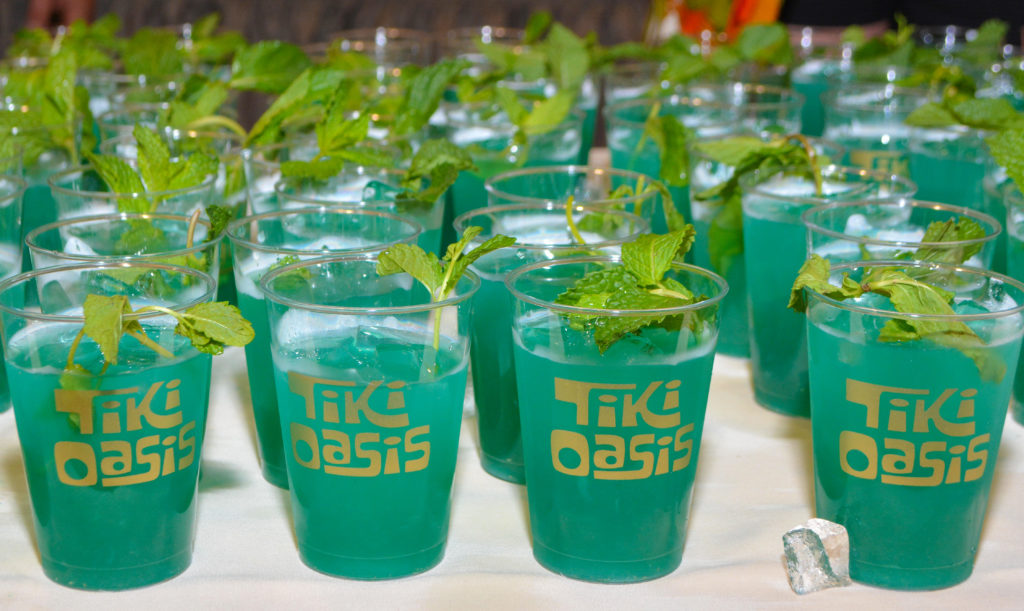
(Albertine)
Certain figures always have a presence as Oasis such as nostalgia king Charles Phoenix, who’ll be doing a slideshow about old Vegas. Renowned artist Shag is another, and he will be debuting an exclusive new print (see photo above) honoring recently passed away “Mr. Tiki Head,” aka L.A. resident Andrew McClain, a beloved fixture on the scene who often showed up at area events disguised under incredible tiki heads he made himself. Kirsten is always involved in some way at Oasis too, and this year is no exception. Though he’s a tiki purist in many ways, he says he found inspiration with the new Oasis theme’s second wave musical mindset. He’ll be doing a slideshow presentation about his punk rock days and how they led him to tiki life. His openness to a more modern theme notwithstanding, the historian does take issue with other non-related cultures tiki-fying everything these days.
“A lot of so called nerd cultures have discovered tiki and have this urge to make it part of their own subcultures or to bring something to it… like meshing Star Wars culture for example, “he says, most likely referring to a line of Star Wars tiki mugs currently on the market or even the new Disneyland Galaxy’s Edge Cantina, which boasts tiki-style drinks. “It started with rockabilly, which actually never really had much to do with tiki. So all these crossover interests that have co-opted tiki and they’re a little bit painful to me.”
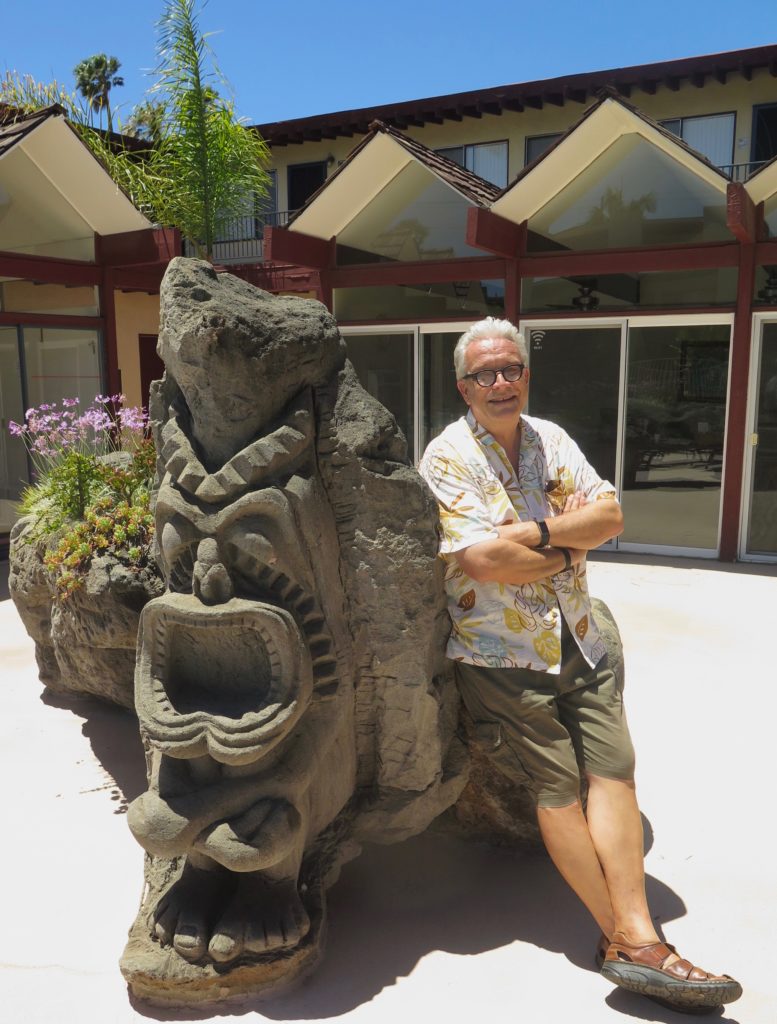
(Courtesy Sven Kirsten)
Disney and Disneyland sort of get a pass when it comes to referencing tiki due to their awesome bar — Trader Sam’s — and of course, their iconic attraction, “The Enchanted Tiki Room,” complete with the nostalgic frozen treats sold nearby, The Dole Whip (Tonga Hut references the pineapple fave in one of their most popular drinks).
When it comes to the mainstreaming of the culture, hardcore tikiheads find a couple other trends more problematic. Chain restaurants calling their sugary concoctions “tiki” just because they have pineapple or coconut in them is a big one. And then there’s the plethora of Party City/Target tiki crap which they feel cheapens the aesthetic (an exception here is plastic cups and sippers for carrying around drinks so you don’t risk breaking your fancy mugs at events like Oasis). Some have even charged cultural appropriation when it comes to the tiki scene (like the viral video of a girl who freaked out on her Uber driver over his “offensive” dashboard hula girl figurine), but for those who know its history that idea is absurd. Tiki culture is part of American culture and tourism is what has helped the islands flourish. The resurgence and renewed interest surely hasn’t hurt Hawaii or Polynesia’s economies today, either.
Ultimately, tiki is about connecting with others and feeling good. “It’s an easily accessible and friendly scene,” says Otto. “Nobody is judging you at a tiki bar. Nobody is going to notice your pants. Just top it off with a Hawaiian shirt and you’re good to go,” to which his wife adds, “You’re kind of forgetting the outside world and all of the crazy chaos of your everyday life in this scene.”
Kirsten concurs, “Tiki was and is a great game to play. It’s a game of creating tropical paradise in your own backyard. You can’t take it too seriously… it’s sort of a tongue in cheek thing. I think we all know at this point that paradise on earth does not exist, but tiki allows you to play with the concept and sort of knowingly pretend that it does exist, and create that for yourself.”
Also see our survey of L.A.’s tastiest tiki drinks right now here.
Advertising disclosure: We may receive compensation for some of the links in our stories. Thank you for supporting LA Weekly and our advertisers.

